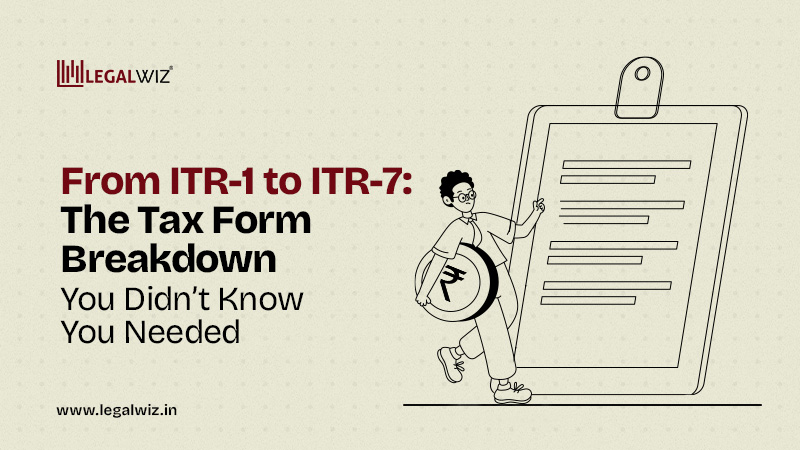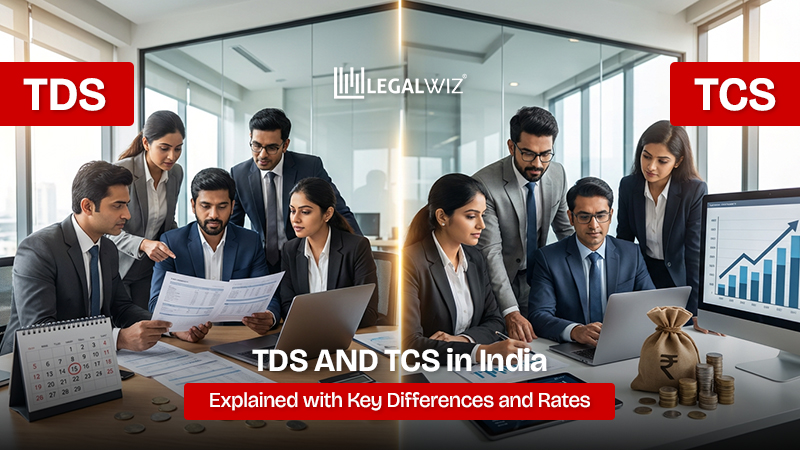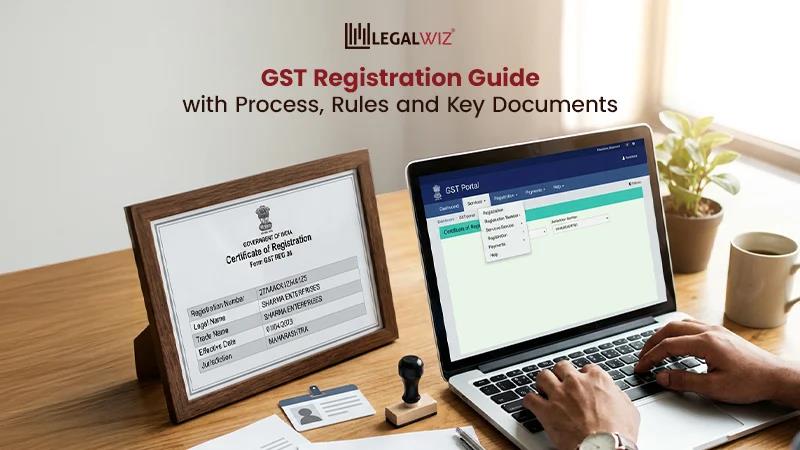The ITR-1 to ITR-7 Form Guide Every Taxpayer Should Read
Wait… there’s MORE than one ITR form? Yep, the tax world loves drama too!
When tax season rolls around, most people Google “how to file ITR” and stop at the first form they see. But here’s the twist: there isn’t just one Income Tax Return form. There are seven. Yep, ITR-1 to ITR-7, each designed for different income types, professions, and entities.
Choosing the wrong ITR form is like wearing someone else’s prescription glasses; things get blurry, fast. You could miss deductions, delay refunds, or even get your return rejected.
That’s why it’s crucial to pick the right one based on how you earn, whether you’re a salaried employee, a side-hustler, a business owner, or part of a trust or NGO.
Whether you’re a 9-to-5er, a crypto-trading freelancer, or running a charitable trust, there’s an ITR form with your name on it. But first, take a quick look at the latest changes in ITR filing for 2025-26 before we decode which form fits you best.
In this guide, we’ll decode each form from ITR-1 to ITR-7, so you can stop guessing and start filing like a pro.
What Is an ITR Form Anyway?
Before we dive into the 1-to-7 breakdown, let’s cover the groundwork: ITR stands for Income Tax Return. It’s a form every taxpayer uses to declare:
- Total income earned in a financial year
- Taxes paid (or payable) on that income
- Claim refunds (if excess tax was deducted)
Whether you’re a salaried employee, a freelancer, or a business owner, filing your ITR is not optional once your income crosses the exemption limit. Even if it’s not mandatory for you, filing voluntarily can be a smart move — think smoother loan processing, faster visa approvals, and keeping your finances squeaky clean.
Basically, your ITR is your annual financial report card — and a digital handshake with the Income Tax Department.
If you’re new to the whole process, you might want to first brush up on the ITR filing fundamentals, what it is, who needs to file, and why it matters.
Now that we’re clear on what an ITR is, let’s meet the seven forms that make it official.
| ITR Form | Who Should File? | Key Highlights |
| ITR-1 (Sahaj) | Salaried individuals, pensioners, income from one house property, and other sources (excluding lottery/winnings) with total income ≤ ₹50 lakh. | Quick, simple, one-page return for most salaried taxpayers. |
| ITR-2 | Individuals and HUFs with income > ₹50 lakh, multiple house properties, capital gains, or foreign assets/income. | Covers more complex income sources without business income. |
| ITR-3 | Individuals and HUFs having income from business or profession (proprietorship). | Designed for freelancers, professionals, and small business owners. |
| ITR-4 (Sugam) | Individuals, HUFs, and firms (other than LLP) opting for presumptive taxation under Sections 44AD, 44ADA, 44AE with income ≤ ₹50 lakh. | Minimal paperwork for presumptive taxpayers. |
| ITR-5 | Partnership firms, LLPs, AOPs, BOIs, and similar entities. | Tailored for non-individual, non-company taxpayers (except those filing ITR-7). |
| ITR-6 | Companies registered under the Companies Act (except those claiming exemption under Section 11). | Corporate tax return for profit-making companies. |
| ITR-7 | Trusts, political parties, charitable/religious institutions, research bodies, etc., are required to file under Sections 139(4A) to 139(4F). | The go-to form for entities claiming tax exemptions or working for social causes. |
So, you’ve seen all seven ITR forms at a glance. Let’s break them down one by one to help you pick the right match for your tax journey.
ITR-1 (Sahaj): For Salaried Employees and Pensioners
Think of ITR-1 as the comfort food of tax forms, basic, no-fuss, and made for people whose income life doesn’t come with extra toppings. Want the full recipe—who can file, what papers you need, and how to do it step by step? Here’s a quick guide to ITR-1 Sahaj you’ll actually understand.
Who Can File ITR-1?
This form is for resident individuals (sorry, NRIs, not for you!) whose income sources are as clean-cut as:
- Salary or pension (hello, 9-to-5 warriors and retirees)
- One house property (not rented out more than one home)
- Other sources like:
- Savings account interest
- Fixed deposit interest
- Family pension
- Income from agricultural activities up to ₹5,000
All this, provided your total income doesn’t cross ₹50 lakh in the financial year.
If your money comes from a paycheck, a single home, and maybe an FD or two, you’re the ITR-1 poster child.
Who Cannot Use ITR-1?
Even if you earn a salary, the following twists in your income tale disqualify you from using ITR-1:
- Earn money from your own work or side job (like freelancing or consulting) – use ITR-3 or ITR-4 instead
- Sold things like shares, property, or crypto – ITR-2 is for that
- Earn money from another country or have a bank account or house outside India – use ITR-2 or ITR-3
- Own two or more houses – ITR-1 won’t work, try ITR-2
- Own shares in a private company or were a director in a company – go for ITR-2 or ITR-3
- Chose to pay tax on ESOPs later (from a startup) – ITR-1 is not the right form
Simple takeaway:
If you do more than just earn a salary or interest from savings, ITR-1 may not be for you. Use the right form to stay safe.
Why ITR-1 Is So Popular
Because it’s easy to file, quick to process, and perfect for those who don’t need a CA on speed dial, most salaried employees and pensioners fit neatly into the ITR-1 category, which is why it sees millions of filings every year.
It also supports online pre-filled filing via the Income Tax portal, so if your Form 16 and bank interest are in place, you’re just a few clicks away from being tax compliant.
If your income life is peaceful and under ₹50L, ITR-1 keeps it Sahaj (literally means “easy”).
ITR-2: For the Investor & the Salaried Individuals
You’ve got a salary, but also some stocks on the side. Maybe a second house. Perhaps even a little crypto—or a property abroad. If your income life is starting to feel like a multi-asset portfolio, say hello to ITR-2.
Who Can File ITR-2?
This form is meant for individuals and Hindu Undivided Families (HUFs) who:
- Earn income from salary/pension, capital gains, or multiple house properties
- Have income from foreign assets or foreign sources
- Have an agricultural income exceeding ₹5,000
- Have an income above ₹50 lakh
- Have held unlisted equity shares
- We were a director in a company during the year
In short, if you sold shares, mutual funds, real estate, or anything that made you feel like a part-time investor, ITR-2 has your back.
Who Cannot Use ITR-2?
Despite its range, ITR-2 is not for people with business or professional income.
So if you:
- Run a business or freelance
- Earn from a startup, consultancy, or any profession
You’ll need to jump ahead to ITR-3 or ITR-4.
ITR-2 is for those who prefer investing over hustling—think stock trader, not street vendor. Everything about its eligibility, required documents, and filing process is already well laid out in this ITR-2 guide.
When Does ITR-2 Make Sense?
Here are some real-life tax scenarios where ITR-2 becomes your perfect match:
- You sold shares or mutual funds (capital gains!)
- You own more than one property (even if one is self-occupied and the other is rented or vacant)
- You earned interest from a foreign bank account
- You received dividends that require special tax treatment
- You have ESOPs from a foreign employer
If your income sources are more “Wall Street” than “Main Street,” ITR-2 is the form you need.
ITR-3: For Professionals, Freelancers & Consultants
You don’t wait for salary credits, you send invoices. You’ve got clients, maybe a GST registration, and income that doesn’t always come on the 1st of every month. So, basically, ITR-3 filing is for business owners, including freelancers, consultants, or any individuals with income from a business or profession.
Who Can File ITR-3?
Individuals and Hindu Undivided Families (HUFs) who earn income from:
- Business or profession
- Salary, if you’re juggling both a job and a side gig
- Capital gains, like stocks or property sales
- House property (rented or self-occupied)
- Other sources (like interest or lottery winnings)
Whether you’re a freelance designer, CA in practice, a Shopify store owner, or a techie doing side gigs on Upwork, ITR-3 says, “Welcome to the game.”
Real-Life Scenarios That Scream ITR-3:
- You run a proprietorship or an unregistered business
You’re a consultant or independent contractor - You’ve opted out of presumptive taxation (more on that in ITR-4!)
- You have capital gains + business income
- You file a regular Profit & Loss + Balance Sheet
If you send client invoices, pay self-employment tax, and occasionally curse Excel sheets, this is your tax form.
Who Should Not Use ITR-3?
If you don’t have business or professional income, skip this one.
Also, if you’re eligible for the presumptive taxation scheme, you may prefer the simpler ITR-4 (Sugam).
ITR-3 is for the doers, the builders, the ones who don’t clock in — they cash in.
ITR-4 (Sugam): For Small Businesses and Presumptive Taxpayers
If you’re running a small business, working independently, and not a fan of spreadsheets filled with every expense and income line, ITR-4 is your shortcut to tax compliance. It’s built for those opting for the Presumptive Income Scheme, where your income is calculated on assumed profits instead of actuals.
Translation? Less paperwork, fewer calculations, more peace.
Who Can File ITR-4?
This form is for resident Individuals, HUFs, and Firms (except LLPs) with:
- Income from business or profession under Sections 44AD, 44ADA, or 44AE (Presumptive taxation)
- Gross receipts up to ₹2 crore for businesses
- Gross receipts up to ₹50 lakh for professionals (doctors, designers, consultants, etc.)
- Income from salary, one house property, or other sources (like interest) can be included too
If your income life is simple but self-driven, this form is a “set-it-and-forget-it” tax mode.
Who Cannot Use ITR-4?
Skip Sugam if you:
- Have capital gains
- Have foreign income or foreign assets
- Own more than one house property
- Are a director in a company or hold unlisted equity shares
- Have income from speculative business, commission, or brokerage
Think of ITR-4 as ITR-3’s chill cousin, no ledgers, no audits (in most cases), and no tax-time panic.
Why It’s a Fan Favorite (Among Small Biz Owners)
- No need to maintain detailed books of accounts
- You’re taxed on a fixed percentage of your gross receipts (e.g., 6% or 8% for businesses, 50% for professionals)
- Filing is quick, clean, and practically Zen-like
If your business is small but steady, and you like simplicity over scrutiny, ITR-4 is your vibe. Let’s go through the step-by-step process to file ITR-4, keeping it beginner-friendly and fuss-free for presumptive taxpayers.
ITR-5: For Partnership Firms That File Together
This one’s for the teams. ITR-5 is the tax return form designed for entities where income is earned collectively, not individually. Think partnerships, trusts, and associations that operate with a shared purpose — and shared profits.
If you run a business with co-founders or manage a fund or trust, this form’s got your back (and balance sheet).
Who Can File ITR-5?
ITR-5 is meant for entities like:
- Partnership firms (registered or unregistered)
- LLPs (Limited Liability Partnerships)
- AOPs (Association of Persons)
- BOIs (Body of Individuals)
- Artificial Juridical Persons
- Estates of deceased or insolvent individuals
- Business trusts and investment funds under Sections 115UA/115UB
If it’s not a solo gig and not a registered company, it probably goes here.
Who Cannot Use ITR-5?
You can’t use ITR-5 if you are:
- An individual taxpayer (use ITR-1 to ITR-4)
- A company (hello, ITR-6!)
- Filing under ITR-7 criteria (like NGOs, political parties, etc.)
It takes a team to use the ITR-5, and this form accommodates everyone except solo players and corporate giants.
Bonus Tip: Digital Filing Only
Most entities filing ITR-5 must submit returns electronically with a digital signature, especially if audit provisions apply.
ITR-5 is built for partnerships, LLPs, and other groups that file returns collectively — and ideally, grow together too. Still not sure if this form is for you? No worries. We’ve got a detailed guide that explains what ITR-5 is and who should file it, as well as the key documents and rules to follow.
ITR-6: For Companies Only
If you’re running a registered company, chances are you’re required to file your taxes with the ITR-6 form. This one’s built strictly for businesses, not partnerships, not trusts, not individuals, and definitely not for charitable institutions.
Think of ITR-6 as the suit-and-tie form of the tax world. All business, no fluff.
Who Can File ITR-6?
Only companies registered under the Companies Act can file ITR-6, as long as they’re not claiming exemption under Section 11. Let’s understand the complete ITR-6 filing process and how it makes company tax filing less of a headache.
This includes:
- Private limited companies
- Public limited companies
- One Person Companies (OPCs)
- Startups registered as companies
If your company earns income from business, investments, or both, and isn’t operating for charitable purposes, ITR-6 is your fit.
Who Cannot Use ITR-6?
- Companies claiming exemption under Section 11 (i.e., charitable or religious trusts)
- Firms, LLPs, and individuals
- Non-profit companies like societies, NGOs, or AOPs
This one’s strictly “members only” — corporate members, that is.
Important: E-Filing Only
- ITR-6 must be filed electronically
- With a digital signature (DSC)
- Audit-reporting companies must ensure forms are submitted well before deadlines to avoid penalties
If you’re in the corporate league, filing taxes with ITR-6 isn’t optional — it’s protocol.
ITR-7: When Profit Isn’t the Point
Not all income is made for profit; some is made for purpose. That’s where ITR-7 comes in. This form is reserved for institutions and entities that exist to serve, not sell.
Whether you’re running a charitable trust, a research institution, or a political party, ITR-7 is your official handshake with the tax department. Want to know how it works? Here’s a step-by-step guide to ITR-7 return filing, including who needs to file and what’s required.
This one’s for the do-gooders. If your mission is impact over income, this is your form.
Who Can File ITR-7?
Entities that file returns under Sections 139(4A) to 139(4F) of the Income Tax Act, including:
- Charitable and religious trusts
- Political parties
- Scientific research institutions
- Universities and colleges
- News agencies
- Trade unions
- Medical or educational institutions claiming tax exemption
If you’re exempt from tax but not from compliance, ITR-7 is your route.
Who Cannot Use ITR-7?
If your entity is:
- A regular company (file ITR-6)
- A firm, LLP, or individual
- Not eligible for exemption under the applicable sections
Then ITR-7 won’t apply.
Compliance Still Counts
Just because these entities don’t pay tax like for-profits doesn’t mean they’re off the hook. Filing ITR-7 is mandatory if they want to maintain:
- Section 12A / 10(23C) exemptions
- Credibility with donors and the public
- Clean audit trails for government scrutiny
Even if you serve society, the Income Tax Department still wants the paperwork.
Choosing the Wrong ITR = Oops Tax Trouble
So, why does all this form-matching matter? Because filing the wrong ITR form isn’t just a minor mistake — it can lead to major tax chaos.
Here’s what could go wrong:
- Your return could get rejected by the Income Tax Department
- Refunds may be delayed (yes, even if you’re owed money!)
- You might miss out on eligible deductions or exemptions
- You may end up filing a revised return, which means more work (and possibly penalties)
Filing ITR-1 when you should’ve used ITR-3 is like bringing a spoon to cut a cake — it just won’t work.
Mini Tip Box: How to Pick the Right ITR Form
- Know your income types — Salary? Business? Capital gains?
- Check if presumptive taxation applies — If yes, ITR-4 might be for you
- Capital gains involved? — You’re probably looking at ITR-2 or ITR-3
- Running a business or freelancing? — Hello, ITR-3 or ITR-4
- Claiming foreign income or assets? — Steer clear of ITR-1 and 4
- Company or LLP? — You’re in ITR-5 or ITR-6 territory
Let LegalWiz.in Pick the Right Form for You
Still confused between ITR-2 and 3? Not sure if your side hustle counts as a business?
No worries – LegalWiz.in makes it simple.
- 100% digital filing – No paperwork, no confusion
- Reviewed by expert CAs – So your return is clean, compliant, and complete
- Affordable & accurate – No hidden fees, no rookie mistakes
- End-to-end support – From choosing the right ITR form to getting that sweet refund
Don’t guess your ITR form. Let our experts do it for you.
Final Thoughts: ITR Form ≠ Just a Number
Income tax return filing isn’t just about hitting “submit”; it’s about choosing the right form that actually fits your financial life.
You wouldn’t wear shoes three sizes too small – so why file the wrong ITR?
Whether you’re a salaried pro, a stock market ninja, a freelance hustler, or running a trust, there’s a form made just for you. Picking the wrong one can lead to rejections, delays, or missed benefits, and nobody’s got time for that.
Pick smart. File right. Stay tax-trouble-free. And if in doubt? You know who to call, LegalWiz.in.
Frequently Asked Questions
What is an ITR form, and why is it important?
Think of an ITR form as your annual “Dear Taxman” letter. It spills the tea on your earnings, taxes paid, and refund claims. File it right, and you’re the teacher’s pet of the Income Tax Department. File it wrong—or not at all—and you’re asking for extra homework.
How do I know which ITR form I should file?
Your ITR form is like picking shoes—one size does not fit all. Salaried, business income, capital gains, foreign assets—each needs its own pair. Get it wrong, and you’ll be tripping over rejections or delayed refunds. Platforms like LegalWiz.in are basically your tax stylist.
Can I revise my ITR if I filed the wrong form?
Sure, the tax department gives you a do-over pass called a revised return. But honestly, it’s like fixing a text you sent to your boss at 2 AM—you’d rather not be in that situation. Nail the right form first and skip the drama.
What happens if I don’t file my ITR at all?
Skipping ITR filing is like ghosting the government—it never ends well. You could face fines up to ₹5,000, interest piling up like credit card bills, and a hard “Nope” on future loans or visas. Filing on time = adulting done right.
Do salaried employees have to file ITR-2 instead of ITR-1?
Yep, if your income crosses ₹50 lakh, you dabble in capital gains, juggle multiple houses, or own foreign assets, ITR-2 is your soulmate. Salary alone doesn’t guarantee ITR-1 eligibility—your entire money story makes the match.

Sapna Mane
Sapna Mane is a skilled content writer at LegalWiz.in with years of cross-industry experience and a flair for turning legal, tax, and compliance chaos into clear, scroll-stopping content. She makes sense of India’s ever-changing rules—so you don’t have to Google everything twice.







